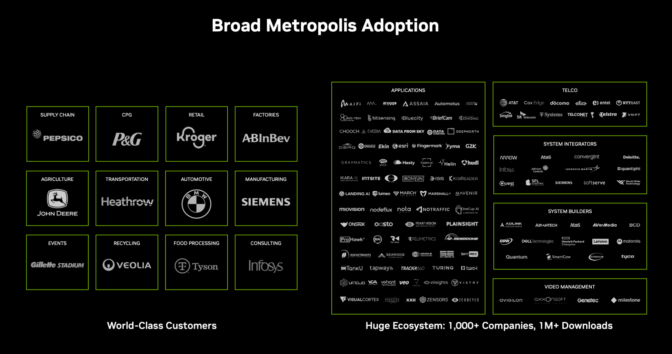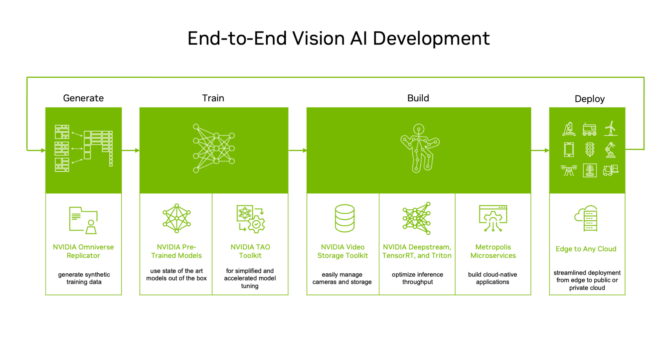With AI at its tipping point, AI-enabled computer vision is being used to address the world’s most challenging problems in nearly every industry.
At GTC, a global conference for the era of AI and the metaverse running through Thursday, March 23, NVIDIA announced technology updates poised to drive the next wave of vision AI adoption. These include NVIDIA TAO Toolkit 5.0 for creating customized, production-ready AI models; expansions to the NVIDIA DeepStream software development kit for developing vision AI applications and services; and early access to Metropolis Microservices for powerful, cloud-native building blocks that accelerate vision AI.
Exploding Adoption and Ecosystem

More than 1,000 companies are using NVIDIA Metropolis developer tools to solve Internet of Things (IoT), sensor processing and operational challenges with vision AI — and the rate of adoption is quickening. The tools have now been downloaded over 1 million times by those looking to build vision AI applications.
PepsiCo is optimizing its operations with NVIDIA Metropolis to improve throughput, reduce downtime and minimize energy consumption.
The convenience-food and beverages giant is developing AI-powered digital twins of its distribution centers using the NVIDIA Omniverse platform to visualize how different setups in its facilities will impact operational efficiency before implementing them in the real world. PepsiCo is also using advanced machine vision technology, powered by the NVIDIA AI platform and GPUs, to improve efficiency and accuracy in its distribution process.
Siemens, a technology leader in industrial automation and digitalization, is adding next-level perception into its edge-based applications through NVIDIA Metropolis. With millions of sensors across factories, Siemens uses NVIDIA Metropolis — a key application framework for edge AI — to connect entire fleets of robots and IoT devices and bring AI into its industrial environments.
Automaker BMW Group is using computer vision technologies based on lidar and cameras — built by Seoul Robotics and powered by the NVIDIA Jetson edge AI platform — at its manufacturing facility in Munich to automate the movement of cars. This automation has resulted in significant time and cost savings, as well as employee safety improvements.
Making World-Class Vision AI Accessible to Any Developer on Any Device
As AI is made accessible to developers of any skill level, the next phase of AI adoption will arrive.
GTC is showcasing major expansions of Metropolis workflows, which put some of the latest AI capabilities and research into the hands of developers through NVIDIA TAO Toolkit, Metropolis Microservices and the DeepStream SDK, as well as the NVIDIA Isaac Sim synthetic data generation tool and robotics simulation applications.

NVIDIA TAO Toolkit is a low-code AI framework that supercharges vision AI model development for practically any developer, in any service, on any device. TAO 5.0 is filled with new features, including vision transformer pretrained AI models, the ability to deploy models on any platform with standard ONNX export, automatic hyperparameter tuning with AutoML, and AI-assisted data annotation.
STMicroelectronics, a global leader in embedded microcontrollers, integrates TAO into its STM32Cube AI developer workflow. TAO has enabled the company to run sophisticated AI in widespread IoT and edge use cases that STM32 microcontrollers power within their compute and memory budget.
The NVIDIA DeepStream SDK has emerged as a powerful tool for developers looking to create vision AI applications across a wide range of industries. With its latest update, a new graph execution runtime (GXF) allows developers to expand beyond the open-source GStreamer multimedia framework. DeepStream’s addition of GXF is a game-changer for users seeking to build applications that require tight execution control, advanced scheduling and critical thread management. This feature unlocks a host of new applications, including those in industrial quality control, robotics and autonomous machines.
Adding perception to physical spaces often requires applying vision AI to numerous cameras covering multiple regions.
Challenges in computer vision include monitoring the flow of packaged goods across a warehouse or analyzing individual customer flow across a large retail space. Metropolis Microservices make these sophisticated vision AI tasks easy to integrate and deploy into users’ applications.
Leading IT services company Infosys is using NVIDIA Metropolis to supercharge its vision AI application development and deployment. The NVIDIA TAO low-code training framework and pretrained models help Infosys reduce AI training efforts. Metropolis Microservices, along with the DeepStream SDK, optimize the company’s vision processing pipeline throughput and cut overall solution costs. Infosys can also generate troves of synthetic data with the NVIDIA Omniverse Replicator SDK to easily train AI models with new stock keeping units and packaging.
Latest Metropolis Features
Tap into the latest in NVIDIA vision AI technologies:
- Read the TAO 5.0 blog. Try TAO Toolkit on NVIDIA LaunchPad.
- GXF runtime, now part of NVIDIA DeepStream, unlocks new use cases that require tight scheduling control. Try it on NVIDIA LaunchPad.
- Sign up for early access to Metropolis Microservices, a suite of cloud-native microservices and reference applications that accelerate efforts to create API-driven solutions for the edge and the cloud.
- Learn more about NVIDIA Metropolis — through corporate blogs, technical blogs and case studies — to see how vision AI is transforming the world.
Register free to attend GTC, and watch these sessions to learn how to accelerate vision AI application development and understand its many use cases.
Watch NVIDIA founder and CEO Jensen Huang’s GTC keynote in replay:
